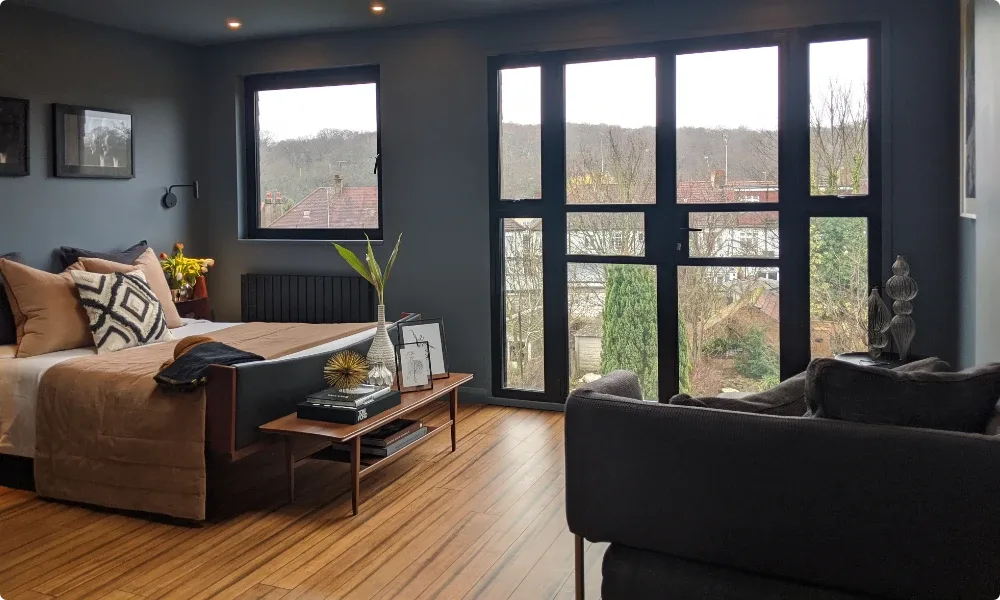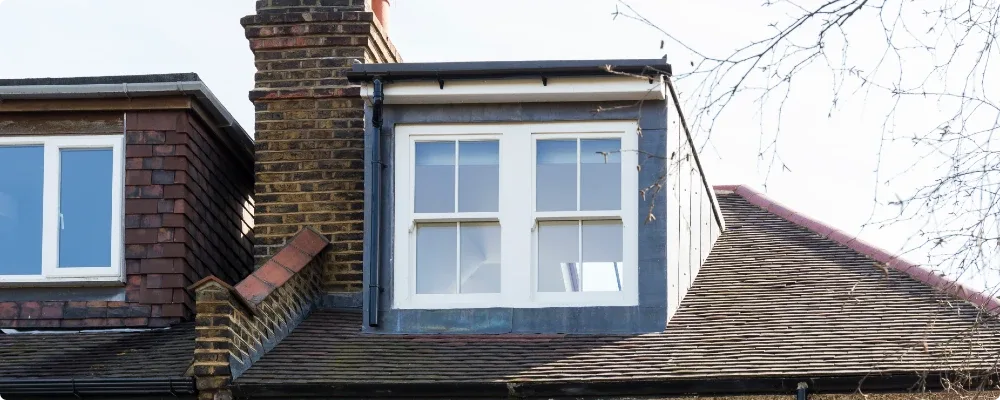1. Bigger isn’t always better
Not all dormers have to be big. In fact, due to strict planning restrictions in this conservation area, our team designed this dormer (see below) to be smaller than your standard model. Yet even with this small addition, we were still able to create a bright, and spacious double bedroom, as well as an ensuite next door.
On the exterior, we blended many of the elements that give this townhouse its charm, including a mirrored window design between the loft and the downstairs glazing, plus a slick grey exterior on the dormer itself to match the tones of the original roof.
2. Work with existing features
Looking for plenty of extra space? Then your dormer can certainly provide that too.
If you do want to create a large addition, then you can avoid the structure from overpowering the look of your home by working with the original features. This could mean mimicking the grey slate already installed on your roof, or even matching your dormer to other areas of your home.
Should you already have a rear extension of bi-fold doors in place, your architect can match the frames or exterior finishes to the top of your property. This creates continuity to the facade of your property and can help modernise an older property, without the additions feeling out of place.
3. Maximise your glazing
If you have the budget, why not make the most out of your new vantage point?
As long as it doesn’t affect the privacy of your neighbours, large windows or even a balcony can make all the difference inside your new space. Our Science of a Happy Home report discovered that even a small balcony can give a huge boost to wellbeing, letting the mind feel connected to nature and calmed.
From a planning perspective, balconies can be quite contentious and will require a full planning application (unless you opt for a Juliet style balcony). However, the best part of researching loft conversions is that it’s pretty easy to look for precedent in your area. Simply have a nose around your neighbourhood to see if anyone else has created a similar kind of dormer. If you spot a few examples, it’s usually a good sign that your council will be open to your designs.
4. Work with the best professionals
Having an architect on board isn’t a legal requirement, but if you’re hoping to avoid ugly design then they’re one of the best professionals to turn to.
Unlike a design and build company, architects specialise in designing beautiful spaces, and can even help you navigate the rest of the journey. A good architect will help you establish the best planning route and manage this process on your behalf, ensuring you get the best level of design within the planning requirements - either through a full planning application or by using your permitted development rights.
While you might be wary about an extra expense, the pay-off from great design makes hiring an architect a fantastic investment. Chances are they’ll be able to unlock more space for your money and get it working harder for your family. This means better tailoring to your lifestyle PLUS a higher chance of recouping your costs during a future sale.

Additional tips for creating your dream dormer...
Dormer extensions can come under your permitted development rights, so if your council is known for being strict, this can be a way around any subjective decision making. However, you’ll need to make sure your home qualifies. Take our test to find out.
If your project impacts a shared wall with a neighbour, you’ll need to serve a party wall notice before you start any construction. This can be done by either yourself or a party wall surveyor - though we always recommend you use a professional.
Not all loft conversions need to look so modern. There are plenty of dormer windows that mimic those classic cottage style frames. As with all extensions, you’ll be surprised by the design possibilities!
Don’t skim on the quality of your insulation. Most of the heat in your home is lost through your roof, so an extension is a perfect way to address this. By spending money on high-quality insulation now, you’ll recoup the costs in the long run by saving money on your bills. Plus, many homebuyers are now looking for energy-efficient features.
For more tips and tricks on loft conversions, dormers, and other extensions, book a free consultation with our team.







